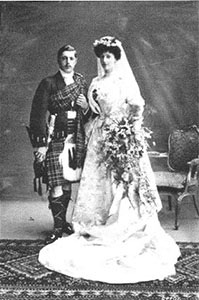Died in action aged 32
Buried in the Bethune Town Cemetery at III M 10.
Lord Ninian Edward was born at Dumfries House, the second son of John Patrick 3rd Marquess of Bute and his wife the Hon Gwendoline Mary Anne, eldest daughter of Lord Edward George Fitzalan-Howard, 1st Baron Howard of Glossop.
After Harrow and a year at Christ Church in 1901, Lord Ninian was commissioned in 1903, into the 3rd Battalion of the Queen’s Own Cameron Highlanders and the following year was gazetted 2nd Lieutenant and served for two years in 1st Battalion, the Scots Guards.
He married on 16 June 1906, the Hon. Ismay Lucretia Mary Preston daughter of the 14th Viscount Gormanston and left the army to concentrate on politics, passing into the Reserve of Officers in 1907 and promoted to Lieutenant in 1908.
In January 1910, he was adopted as the Unionist candidate for the United Boroughs of Cardiff, Cowbridge and Llantrisant. He was defeated by Mr D A Thomas but was successful in winning the seat at the General Election in the following December.
 He was the Keeper of Falkland Palace, President of the Fife Agricultural Society, a member of the Fife County Council and of the Glamorgan Territorial Force Association. When the local football club were seeking guarantors for the construction of their ground, Lord Ninian was a principal supporter and to express their appreciation of his generosity, the Cardiff City Football Club named their ground Ninian Park.
He was the Keeper of Falkland Palace, President of the Fife Agricultural Society, a member of the Fife County Council and of the Glamorgan Territorial Force Association. When the local football club were seeking guarantors for the construction of their ground, Lord Ninian was a principal supporter and to express their appreciation of his generosity, the Cardiff City Football Club named their ground Ninian Park.
On 9 March 1911 he became Lieutenant-Colonel 6th Welsh Territorials, and in 1912 took command. On the outbreak of the European War, he volunteered with the entire battalion for foreign service. In an address to his men before leaving for the front, he said: “I am prepared, as I am sure you are, to lay down my life for my country if required.” They served with the Expeditionary Force in France from October 1914. On 2 October 1915, after sixteen hours on the road and two days without sleep, the 6th Welsh took part in a night attack on the Hohenzollern Redoubt near La Bassee.
Sergeant Russell stated that by a brilliant bayonet charge, the British had taken a section of enemy trenches from which they were ultimately driven out by the Germans using aerial torpedoes and bombs. Major R C Browning was in the captured trench when the Germans attacked, and our men had to retire, exposed to machine-gun and rifle fire. It was then found that the Major was not with them, and “When our Colonel, Lord Ninian Stuart, was told that Major Browning was left in the trench he nearly went frantic, as they were bosom friends. By leading us to another attack to try and save Major Browning, our Colonel lost his own life. Standing up to lead his men, Lord Ninian was shot in the head by a sniper’s bullet and died, instantly.” Major Browning was later reported ‘missing’.
He is commemorated by a statue at Gorsedd Gardens, Cathays Park, Cardiff.
His Will was sealed on 22 December 1915, confirmed by Lord Colum Crichton-Stuart and Robert Octavius Pitman, WS (Scottish Will)
He left a six-month-old son who followed his father to Christ Church, and two daughters. His eldest son had died when three years old in 1910.
Of the eight hundred and forty-two original members of the 6th Battalion, only thirty survived at the Armistice.
His father, 3rd Marquis of Bute, a convert to Catholicism, who had inherited the title as an infant, used his great wealth in a number of philanthropic ways, one of which was the restoration of Cardiff Castle and the Bute family was greatly esteemed in the city.
